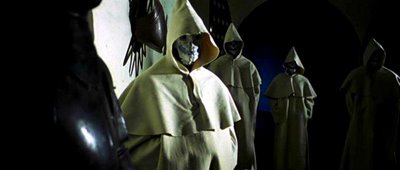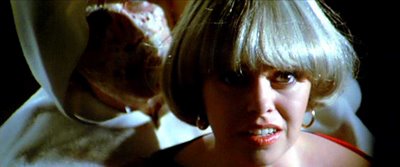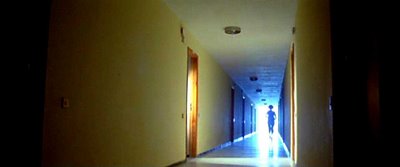
MANSION OF THE LIVING DEAD
La Mansión de los Muertos Vivientes
1982, Severin Films, DD-2.0/16:9/ST/+, $29.95, 92m 47s, DVD-0
Widely misperceived as a rip-off or response to the "Blind Dead" films of Amando de Ossorio, MANSION OF THE LIVING DEAD is actually Franco’s improvisation on ideas found in the stories of Andalusian writer Gustávo Adolfo Bécquer (1836-70), whose work also provided the basis of John Gilling’s little-seen LA CRUZ DEL DIABLO (1975) and was a possible source of inspiration for Ossorio. That said, Franco’s film also functions as a comment on the “Blind Dead” films, serving as both a brutal exposé of what is silliest about them, and a grudging genuflection to their perverse beauty.
Four giggly women, all topless waitresses from Munich ("It's 'in' right now"), arrive at a beach hotel described by their travel agent as "almost like Heaven on earth." Indeed it is, but in the most unsettling sense: there's no sign of life anywhere. A sinister hotel manager, Carlos ("Robert Foster" aka Antonio Mayans dyed blonde), assigns to the four ladies two rooms on opposite sides of the building, claiming that the hotel is too full to accomodate them any nearer to one another. The conveniently bisexual women wile away the hours till men arrive by having sex with each other, after which they begin to be individually lured to a nearby disused church by the beckoning sound of a dirge. Residing within the church they discover the undead members of the "Holy Court of the Cathar," accursed with ever-lasting life for their satanic practices, who punish these silly sinners by gang-raping them, while praying to their lord to "protect them from feeling any pleasure while carrying out this sinner's sentence." By the time Candy ("Candy Coster," a platinum blonde-wigged Lina Romay) finds her way to the church, Carlos -- secretly one of the ancient sect's brethren -- has recognized her as the reincarnation of Princess Irina, burned at the stake by the brethren ages before, whose loving forgiveness is the only possible salvation from him and the other devil worshippers.
Lina Romay played a Countess Irina in FEMALE VAMPIRE, of course, and that's one of many in-jokes in this schizophrenic film, which opens almost as a comic spoof of the teenage body-count movies popular at the time this film was made, then slowly grows more serious as it trundles along down dark corridors with an oversized bare bottom (literally). This is no place for viewers curious about that Franco fellow to start exploring, nor is this the sort of horror movie one could recommend to people looking for spooky Halloween viewing; there's no gore to speak of, and it's childish in the most adult terms. Though it's technically softcore, the nudity and erotic activity remain fairly explicit and would certainly be slapped with an NC-17 if rated today. But for those already familiar with the wanky laws governing the Franco universe, the film is a guilty pleasure on the basis of its experimentalism, and it manages an effective sequence or two, against all odds. The apocalyptically vacant hotel that is fully occupied according to the books is an eerie conceit, not to mention a potent metaphor for death, and the mise en scène of the empty hotel and its gleaming, empty corridors recalls Kubrick's THE SHINING (1980) as well as Willard Huyck's MESSIAH OF EVIL (1975).
Furthermore, in seeming response to a similar experiment performed by Dario Argento's TENEBRAE (1981), but actually dating back to VAMPYROS LESBOS (1970) in his own filmography, Franco dares stage nearly all of his horror sequences in direct, open sunlight, an inversion motif that is carried over to the bone-bleached color of the zombie monks' Templar-like robes. An intriguing subplot involving Eva Léon as Carlos' mad wife, chained to a bed in one of the hotel's empty rooms, owes something to THE SHINING's lady in Room 327 and is creepily well-played by Léon and Mayans. These and other compelling qualities, including the surprisingly romantic tone of the finale, are not quite full apology for the fact that much about the film is ridiculous (beginning with "based on the novel by David Khunne," and including dialogue like "Who would want to murder four hotties like us?"), yet for anyone with the imagination to laugh with this film, as well as at it, MANSION OF THE LIVING DEAD might be a strange taste worth acquiring.

Severin Films has given the picture a beautiful, strikingly glassy 2.35:1 presentation (anamorphic) that will draw your eye to small bruises and sores in the clefts of bodies you might not normally examine. A few interior shots look considerably grainier than the exquisitely crisp and colorful balance of the movie, and are clearly the result of shooting in near-darkness with a light-sensitive stock. (The hotel location was obviously off-season, and the film appears to have been almost entirely sun-lit.) The 2.0 mono track is in Spanish only (with optional English subtitles) and very fine, bringing out the best in Pablo Villa's spare score and, for those who know their voices, making it easier to identify secondary characters who were dubbed in post by Jess and Lina. The only extra, a nice one, is a 19-minute visit with Jess and Lina called "The Mansion Jess Built," in which Franco discusses the film's origins in the short stories of Bécquer; his opinions of George Romero, Amando de Ossorio, and zombie movies in general; finally admits for the record that David Khunne's AWFUL DR. ORLOF novel never existed; and explains (as does Lina) the stories behind some of his many pseudonyms. Two of them -- Frank Hollmann and Dave Tough -- show up in the short's end credits as co-editor and music composer, respectively.
MANSION OF THE LIVING DEAD has a street date of October 31, at which time Severin Films will also release Franco's rather more serious erotic voodoo film MACUMBA SEXUAL, starring Ajita Wilson.
